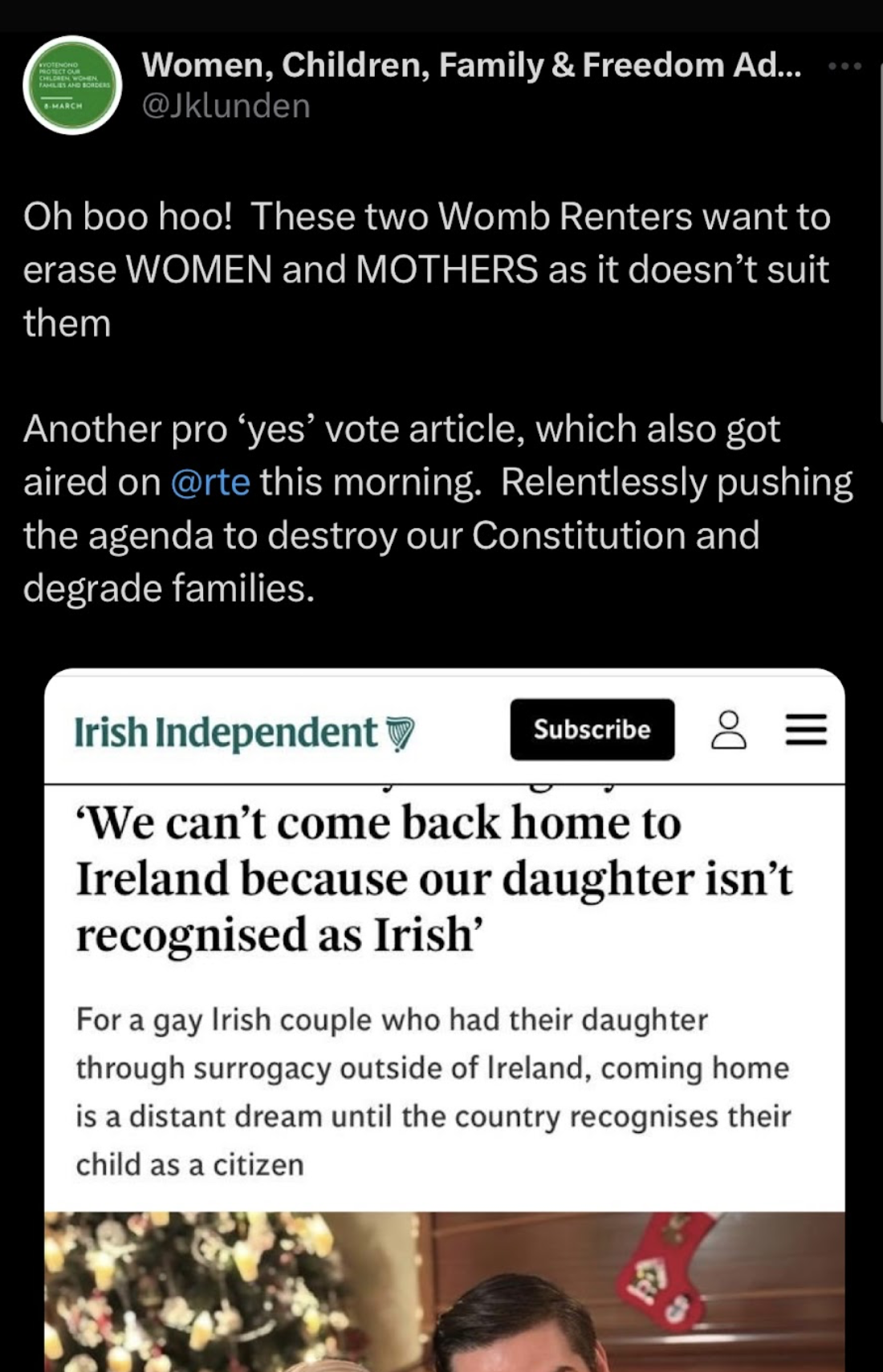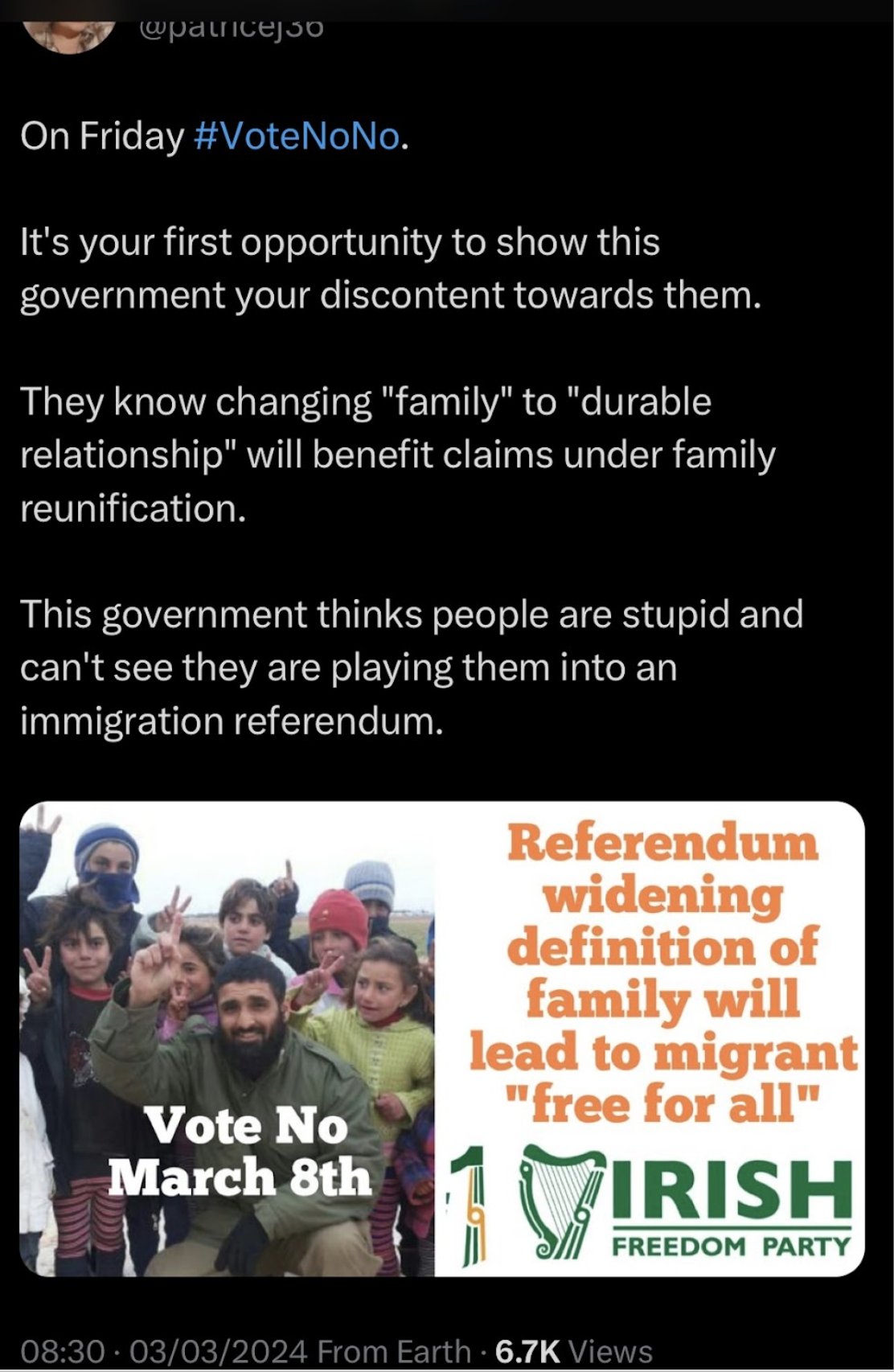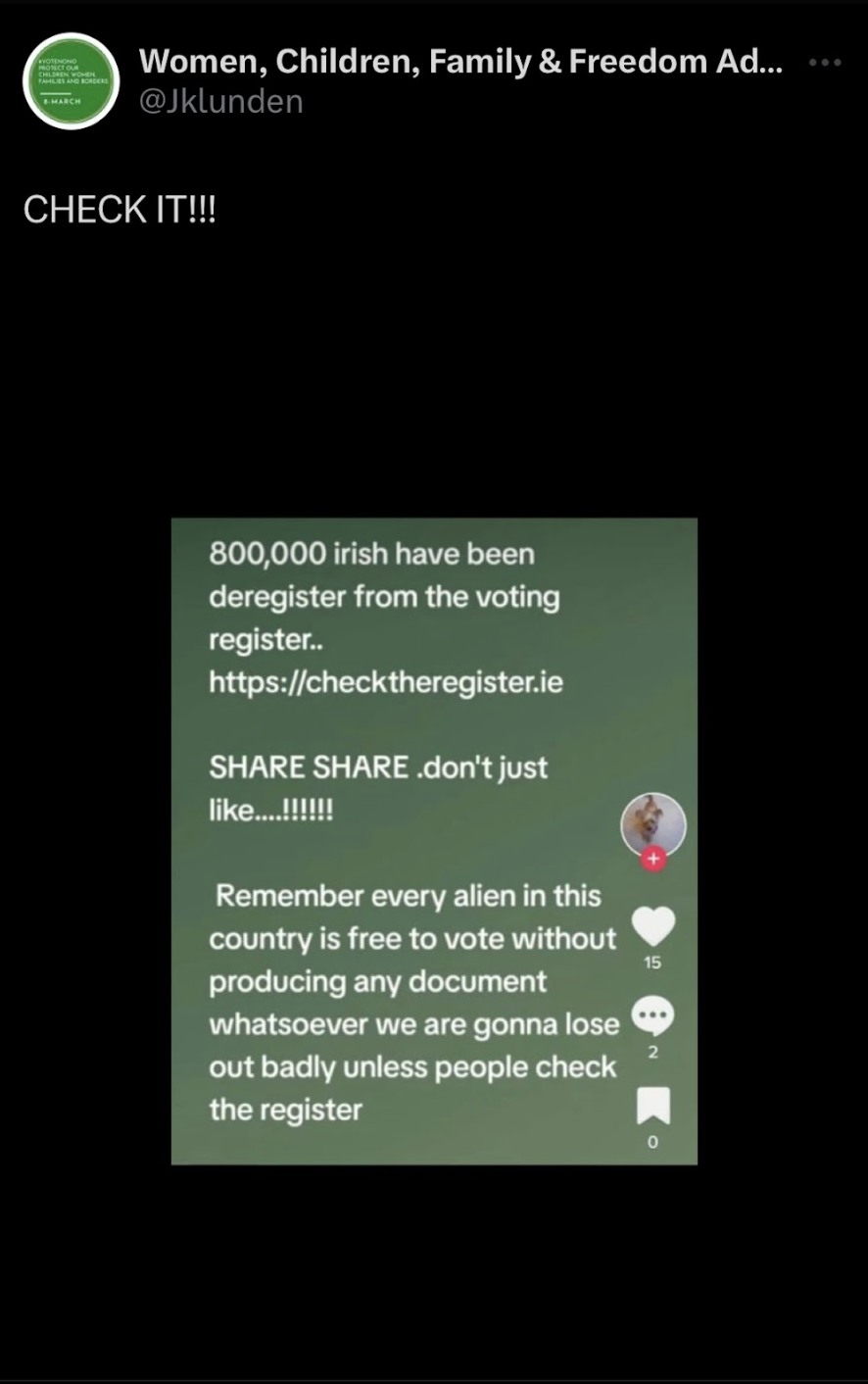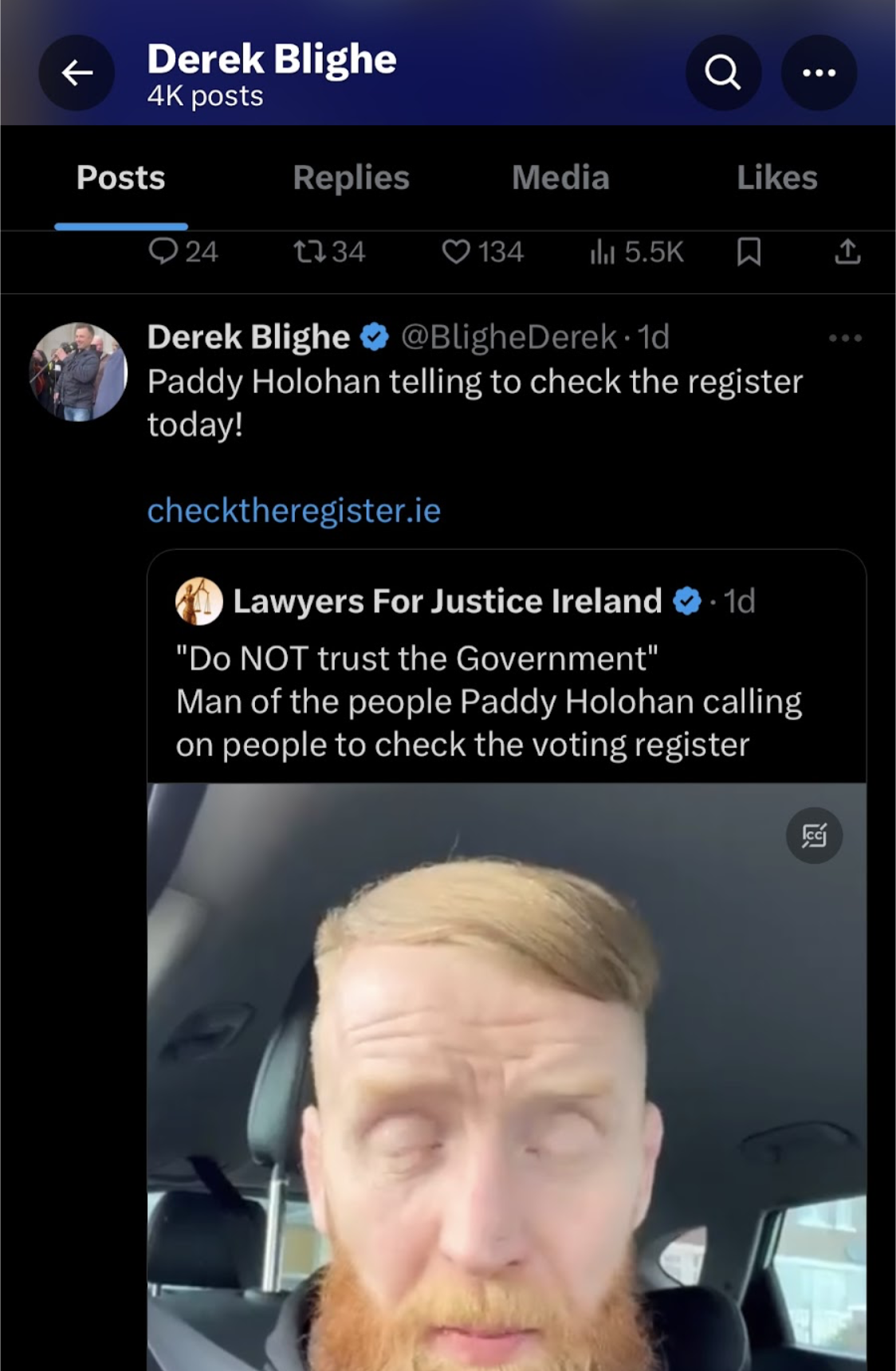Mis or Dis - Referendums and the Far-Right: An Irish Example
On March 8th, 2024, Ireland held a dual referendum in which the Irish people voted on the modification of two constitutional articles. This insight will examine how the far-right leveraged the issues discussed in the referendum, utilizing disinformation to advance their own narratives. There is a chance that the far-right influenced the vote outcome, with an intense vote no/no campaign spearheaded by far-right members like Andy Heasman. The outcome of the referendum was further impacted by the low turnout, with only 44.4% of voters showing up to vote.
The referendums that occurred on March 8th were focused on changing two articles in the Irish Constitution written in 1937. The first centered on the concept of the family within the Constitution. As it stands, Article 41.1.1 states:
“The State recognises the Family as the natural primary and fundamental unit group of Society, and as a moral institution possessing inalienable and imprescriptible rights, antecedent and superior to all positive law.”
and in Article 41.3.1°:
“The State pledges itself to guard with special care the institution of Marriage, on which the Family is founded, and to protect it against attack.” (Bunreacht na hÉirinn, 1937).
The proposed change altered the language of both texts, as follows:
Article 41.1.1° “The State recognises the Family, whether founded on marriage or on other durable relationships, as the natural primary and fundamental unit group of Society, and as a moral institution possessing inalienable and imprescriptible rights, antecedent and superior to all positive law.”
Article 41.3.1° “The State pledges itself to guard with special care the institution of Marriage, on which the Family is founded, and to protect it against attack.” (What are you being asked to decide on? 2024).
The second vote, known as the Care vote, focused on the role of the woman within the Constitution. As it stands, the Constitution states;
Article 41.2.1° “In particular, the State recognises that by her life within the home, woman gives to the State a support without which the common good cannot be achieved.”
Article 41.2.2° “The State shall, therefore, endeavour to ensure that mothers shall not be obliged by economic necessity to engage in labour to the neglect of their duties in the home.” (What are you being asked to decide on? 2024).
The proposed change involved removing the previous articles and replacing them with a new Article 42B, which would state:
“The State recognises that the provision of care, by members of a family to one another by reason of the bonds that exist among them, gives to Society a support without which the common good cannot be achieved, and shall strive to support such provision.” (What are you being asked to decide on? 2024).
Despite reasonable arguments on both sides, the language used in the proposals confused the Irish public and sparked numerous debates. A consistent argument is that the language proposed was too vague and left a lot of unanswered questions, especially about those with disabilities. Many argued that the new wording puts the burden of care on the family, implying that the word strive would mean the State would not have to provide care but support the family to provide the care. Others stated that they did not receive enough information about the referendums before the vote, and that the vote felt rushed.
Democratic principles hold that the right to vote and effect change is a privilege belonging to everyone. Understanding how malicious actors might manipulate narratives is crucial to preventing misinformation that could unduly influence voters, thus undermining democracy.
With numerous elections happening around the world this year, there is a heightened risk of misinformation and disinformation with the intent of causing chaos (link). To combat this, it's important to understand the distinction between the two terms, misinformation and disinformation, which are often used interchangeably. Much like in criminal law, intent is the key difference. Misinformation is misleading but unintentional, whereas disinformation is deliberately shared with the intent to deceive the recipient (Misinformation vs. disinformation - Taylor & Francis Insights 2024).
Disinformation is a tactic used by the far-right to intentionally mislead the public, especially during political upheaval. This is not unique to the Irish far-right—it has also been used by so-called legitimate actors in the United States where, in one example, a democratic consultant paid a New Orleans magician who impersonated President Joe Biden using AI. The use of disinformation is evident in Irish far-right political parties, such as the Irish Freedom Party and the National Party, as well as notable far-right figures on X (formerly known as Twitter) during referendums and other political conversations. This confusion, in turn, allows the far-right to manipulate narratives, exploit uncertainties, and advance their political agendas. The far-right leveraged platforms, such as X, and public forums of far-right political parties to spread disinformation. These approaches contributed to discord and uncertainty and potentially influenced the democratic process by altering the understanding and perceived implications of the proposed constitutional amendments.
The three main narratives tied to the referendums by the far-right are women’s rights, anti-LGBTQ+ sentiment, and immigration. One area of debate was the argument of the role of women in the home. Several politicians campaigning for a “Yes” vote conveyed that the constitution stipulates a woman's place to be in the home. While this interpretation could be derived from the language used, it was exploited by far-right members. The far-right claimed that they were supporting women’s rights and stated that the government was trying to erase women from the constitution and spread misinformation. This narrative also served their anti-transgender and homophobic agenda. Posts on X often read, "Women belong in the constitution - Vote NO/NO," which further aligned with their anti-immigration stance, as evidenced by common hashtags like #irelandbelongstotheirish and #irishlivesmatter (Fig. 1). This rhetoric is linked to past protests against libraries and educational institutions where the far-right asserted that the government was promoting a “gender ideology.” The far-right claimed this was sexualizing children and would allow men identifying as women to have greater access to shared spaces—points irrelevant to the referendum in question.
Fig. 1
Jana Lunden, a notable Irish far-right figure, targeted a news story about a gay Irish couple as being “womb renters” who want to “erase women and mothers” (Fig. 2) whilst replies built on the homophobic tone implying the gay couple are replacing mothers with “two daddies” (Fig. 2.1). Openly gay politician Roderic O’Gorman was also attacked by far-right activist Derek Blighe and others. The far-right unjustifiably implied that he has connections to pedophiles, in an attempt to promote their narrative that gay men are trying to destroy Ireland and marginalize women (Fig. 3).
Members of the far-right often connect their arguments to their other values, in this case associating government parties with previous stances during the library protests in which they argued that the libraries were grooming children. This narrative aligns with the far-right’s anti-trans stance, as many tweets targeted drag queens and the trans community. The far-right claimed, "...they are pushing the removal of natural beautiful women in favor of men with lipstick" (Fig. 4), often attaching pictures of transgender people.
Another clear theme is the connection to anti-immigration, specifically anti-Muslim sentiment. The argument was made that a yes/yes vote would increase migration and prepare Ireland for an alleged takeover by Islam (Fig. 5). This notion was further fueled by disinformation claiming that child marriage would be next if the referendum passed. Lunden and others often circled the conversation back to being linked to open borders and child sexualisation. There were concerns raised about the term “durable relationships” and this was capitalized on by the far-right with some tweeting that this would lead to claims of family reunification and calling it an “immigration referendum,” implying that it would lead to an influx of migrants (Fig. 6).
There was a further link to conspiracy theories with claims that people who were promoting a no/no vote were being removed from the register and that others needed to provide more information to be eligible to vote. These unverified claims were made by parties such as the Irish Freedom Party and by Ireland First (Fig.7; Fig.7.1). Fear-mongering is a tactic frequently employed by the far-right to hijack spaces to attach issues to their own extreme agenda. This targeting and vilifying of minorities and out-groups is malicious and negatively impacts the democratic process.
The key takeaway from this Insight is the importance of maintaining vigilance when dealing with information, particularly in the critical periods leading up to referendums and elections. It is vital to validate your sources of information to ensure their credibility. It encourages the consumption of information from a wide range of perspectives. Being open-minded and receptive to different viewpoints is a valuable trait. It equips you with diverse perspectives, enhancing your ability to make an informed decision. Furthermore, this practice nurtures critical thinking ability, which is an essential skill in today's world of information overload.
Here are links to help you become a more critical consumer of media:
Ireland (and Europe) specific: The Journal’s FactCheck newsletter about trending misinformation - https://www.thejournal.ie/sign-up-factcheck-newsletter-2-5853406-Aug2022/
Interactive Media Bias Chart, which lets you know how biased a source is based on two main criteria: How partisan are they, and how reliable/accurate are they? - https://adfontesmedia.com/interactive-media-bias-chart/
Common Sense Media - https://www.commonsensemedia.org/articles/what-is-media-literacy-and-why-is-it-important
Information on Media Literacy - https://namle.org/resources/media-literacy-defined/
Initiative by the Australian Electoral Commission on disinformation https://www.aec.gov.au/media/disinformation-register.htm












